A company selected 4000 households at random and surveyed them to find out a relationship between income level and the number of televisions sets in a home. The information, so obtained is listed in the following table.
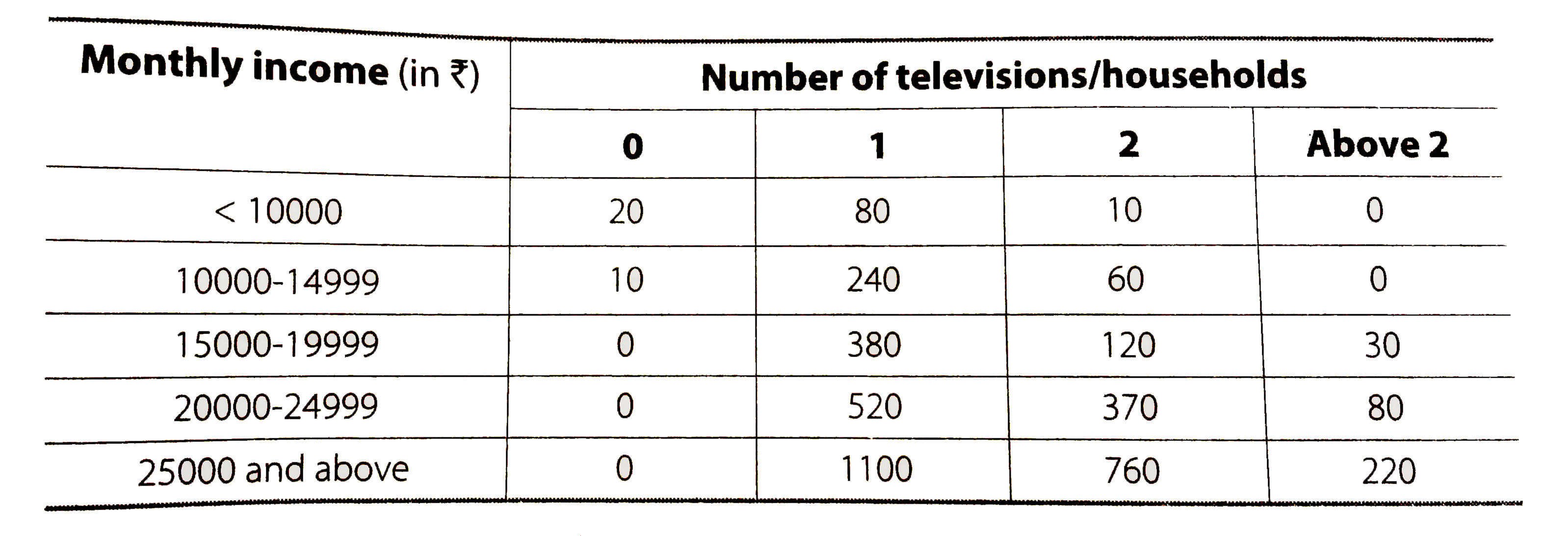
Find the probability
i) of a household earning Rs 10000- Rs 14999 per year and having exactly one television.
ii) of a household earning Rs 25000 and more per year owning 2 televisions.
iii) of a household not having any television.
The total number of the households selected by the company.
n(S)=4000
i) Number of households earning Rs 10000 - Rs 14999 per year and having exactly one television, n(E1)=240
∴ Required probability =n(E1)n(ES)=2404000=6100=350=0.06
Hence, the probability of a household earning Rs 1000 - Rs 14999 per year owning 2 televisions, n(E2)=760
Required probability = n(E2)n(S)=7604000
=0.19
Hence, the probability of a household earning Rs 25000 and more per year owning 2 televisions is 0.19.
Hence, the probability of a household earning Rs 25000 and more per year owning 2 televisions is 0.19.
iii) Number of households not having any televisions, n(E3)=30
∴ Required probability=n(E3)n(S)=304000=3400
Hence, the probability of a household not having any television is 3/400.
Topper's Solved these Questions
- STATISTICS AND PROBABILITYBOOK - NCERT EXEMPLARCHAPTER - STATISTICS AND PROBABILITYEXERCISE - LONG ANSWER TYPE QUESTIONS
5 Videos
- QUADRILATERALS BOOK - NCERT EXEMPLARCHAPTER - QUADRILATERALS EXERCISE - Quadrilaterals
56 Videos
- TRIANGLESBOOK - NCERT EXEMPLARCHAPTER - TRIANGLESEXERCISE - Triangles
55 Videos
Similar Questions
An organisation selected 2400 families at random and surveyed them to determine a relationship between income level and the number of vehicles in a family . The information gathered is listed in the table below
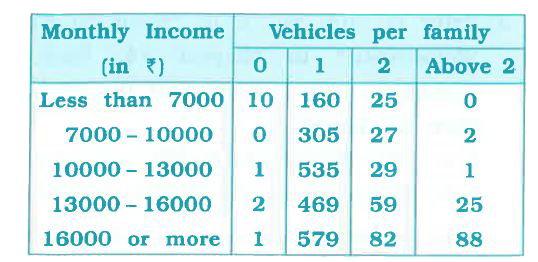
Suppose a family is chosen, Find probability that the family chosen is
earning Rs 10000 - Rs 13000 per month and owning exactly 2 vehicles.
View SolutionAn organisation selected 2400 families at random and surveyed them to determine a relationship between income level and the number of vehicles in a family. The information gathered is listed in the table below.
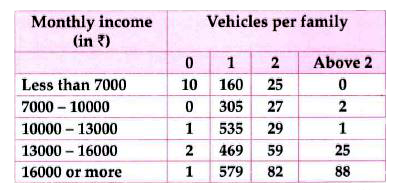
Suppose a family is chosen. Find the probability that the family chosen is
earning Rs 10000 13000 per month and owningexactly 2 vehicles.
View SolutionAn organisation selected 2400 families at random and surveyed them to determine a relationship between income level and the number of vehicles in a family. The information gathered is listed in the table below.
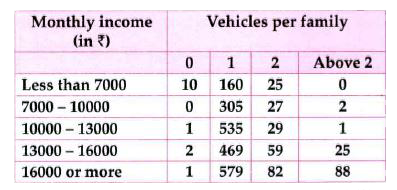
Suppose a family is chosen. Find the probability that the family chosen is
earning Rs 16000 or more per month and owning exactly 1 vehicle.
View SolutionAn organisation selected 2400 families at random and surveyed them to determine a relationship between income level and the number of vehicles in a family . The information gathered is listed in the table below
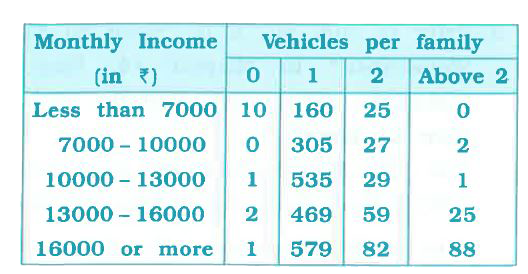
Suppose a family is chosen, Find probability that the family chosen is
earning Rs 16000 or more per month and owning exactly 1 vehicle.
View SolutionAn organisation selected 2400 families at random and surveyed them to determine a relationship between income level and the number of vehicles in a family . The information gathered is listed in the table below
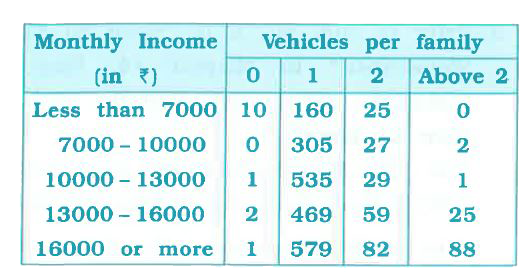
Suppose a family is chosen, Find probability that the family chosen is
earning Rs 13000 - Rs 16000 per month and owning more than 2 vehicles.
View SolutionAn organisation selected 2400 families at random and surveyed them to determine a relationship between income level and the number of vehicles in a family. The information gathered is listed in the table below.
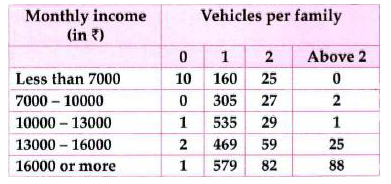
Suppose a family is chosen. Find the probability that the family chosen is
earning Rs 13000-16000 per month and owning more than 2 vehicles.
View SolutionAn organisation selected 2400 families at random and surveyed them to determine a relationship between income level and the number of vehicles in a family. The information gathered is listed in the table below.
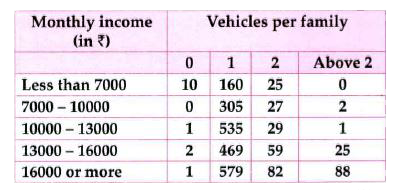
Suppose a family is chosen. Find the probability that the family chosen is
owning not more than 1 vehicle
View SolutionAn organisation selected 2400 families at random and surveyed them to determine a relationship between income level and the number of vehicles in a family . The information gathered is listed in the table below
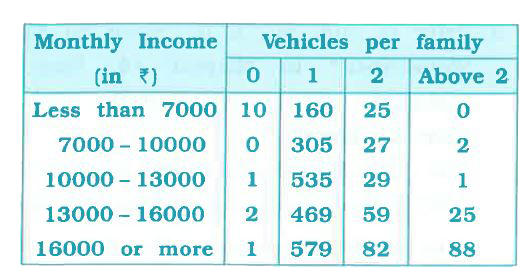
Suppose a family is chosen, Find probability that the family chosen is
owning not more than 1 vehicle.
View SolutionAn organisation selected 2400 families at random and surveyed them to determine relationship between income level and the number of vechicles in a family. The information gathered is listed in the table below:

Suppose a family is chosen. Find the probability that the family chosen is :
(i) earning Rs. 10000-13000 per month and owning exactly 2 vehicles.
(ii) earning Rs. 16000 or more per month and owning exactly 1 vehicle.
(iii) earning less than Rs. 7000 per month and does not own any vehicle.
(iv) earning Rs. 13000-16000 per month and owning more than 2 vehicles.
(v) owning not more than 1 vehicle.
View SolutionAn organisation selected 2400 families at random and surveyed them to determine a relationship between income level and the number of vehicles in a family. The information gathered is listed in the table below.
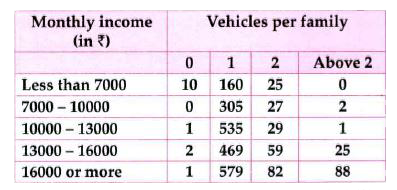
Suppose a family is chosen. Find the probability that the family chosen is
earning less than RS 7000 per month and does not own any vehicle
View Solution
